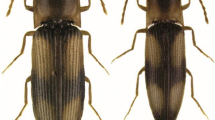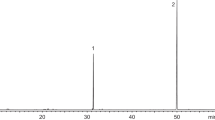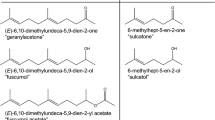Abstract
The sex pheromone of Phyllophaga (Phytalus) georgiana was characterized as valine methyl ester, tentatively the l-enantiomer. This is the first sex pheromone identified from the Phyllophaga subgenus Phytalus. The pheromone was extracted from female glands, the active component isolated by coupled gas chromatography–electroantennogram detection analysis, characterized by mass spectrometry, and shown to be active in field tests. The seasonal flight pattern was determined for P. georgiana as well as for three other species, P. anxia (both northern and southern genitalic forms), P. gracilis, and P. postrema. The latter three species were captured in traps baited with l-isoleucine methyl ester.




Similar content being viewed by others
References
Eberhard, W. G. 1993. Copulatory courtship and morphology of genitalic coupling in seven Phyllophaga species (Coleoptera: Melolonthidae). J. Nat. Hist. 27:683–717.
Evans, A. V., and Smith, A. B. T. 2007. An electronic checklist of the new world chafers (Coleoptera: Scarabaeidae: Melolonthinae) Version 2. <www.museum.unl.edu/research/entomology/nwmelos.htm>.
Harpootlian, P. J. 2001. Scarab beetles (Coleoptera: Scarabaeidae) of South Carolina. Clemson University Public Service Publishing, Clemson.
Koppenhöfer, A., Rodriguez-Saona, C., Polavarapu, S., and Holdcraft, R. J. 2008. Entomopathogenic nematodes for control of Phyllophaga georgiana (Coleoptera: Scarabaeidae) in cranberries. Biocontrol Sci. Technol. 18:21–31.
Leal, W. S., Sawada, M., Matsuyama, S., Kuwahara, Y., and Hasegawa, M. 1993. Unusual periodicity of sex pheromone production in the large black chafer Holotrichia parallela. J. Chem. Ecol. 19:1381–1391.
Lim, K. P., Stewart, R. K., and Yule, W. N. 1980. A historical review of the bionomics and control of Phyllophaga anxia (LeConte) (Coleoptera: Scarabaeidae) with special reference to Quebec. Ann. Soc. Entomol. Que. 25:163–178.
Luginbill, P., and Painter, H. R. 1953. May beetles of the United States and Canada. United States Department of Agriculture. Tech. Bull. No. 1040.
Nojima, S., Linn, C. E., Jr., Morris, B. D., Zhang, A., and Roelofs, W. L. 2003a. Identification of host fruit volatiles from hawthorn (Crataegus spp.) attractive to hawthorn-origin Rhagoletis pomonella flies. J. Chem. Ecol. 29:319–334.
Nojima, S., Robbins, P. S., Salsbury, G. A., Morris, B. D., Roelofs, W. L., and Villani, M. G. 2003b. L-leucine methyl ester: the female-produced sex pheromone of the scarab beetle Phyllophaga lanceolata. J. Chem. Ecol. 29:2439–2446.
Robbins, P. S., Crocker, R. L., Nojima, S., Morris, B. D., Roelofs, W. L., and Villani, M. G. 2003. Methyl 2-(methylthio)benzoate: the unique sulfur-containing sex pheromone of Phyllophaga crinita. Naturwissen. 90:517–520.
Robbins, P. S., Alm, S. R., Armstrong, C. D., Averill, A. L., Baker, T. C., Bauernfiend, R. J., Baxendale, F. P., Braman, S. K., Brandenburg, R. L., Cash, D. B., Couch, G. J., Cowles, R. S., Crocker, R. L., DeLamar, Z. D., Dittl, T. G., Fitzpatrick, S. M., Flanders, K. L., Forgatsch, T., Gibb, T. J., Gill, B. D., Gilrein, D. O., Gorsuch, C. S., Hammond, A. M., Hastings, P. D., Held, D. W., Heller, P. R., Hiskes, R. T., Holliman, J. L., Hudson, W. G., Klein, M. G., Krischik, V. L., Lee, D. J., Linn, C. E. Jr., Luce, N. J., MacKenzie, K. E., Mannion, C. M., Polavarapu, S., Potter, D. A., Roelofs, W. L., Royals, B. M., Salsbury, G. A., Schiff, N. M., Shetlar, D. J., Skinner, M., Sparks, B. L., Sutschek, J. A., Sutschek, T. P., Swier, S. R., Sylvia, M. M., Vickers, N. J., Vittum, P. J., Weidman, R. B., Weber, D. C., Williamson, R. C., and Villani, M. G. 2006. Trapping Phyllophaga spp. (Coleoptera: Scarabaeidae: Melolonthinae) with sex attractants in the United States and Canada. J. Insect Sci. 6:124.
Robbins, P. S., Cash, D. B., Linn, C. E. Jr., and Roelofs, W. L. 2008. Experimental evidence for three pheromone races of the scarab beetle Phyllophaga anxia (LeConte). J. Chem. Ecol. 34:205–214.
Woodruff, R. E., and Beck, B. E. 1989. The scarab beetles of Florida (Coleoptera: Scarabaeidae) Part II. The May or June beetles (genus Phyllophaga). Arthropods of Florida and neighboring land areas. Florida Department of Agriculture and Consumer Services. Division of Plant Industry, Gainesville.
Zhang, A., Robbins, P. S., Leal, W. S., Linn, C. E., Jr., Villani, M. G., and Roelofs, W. L. 1997. Essential amino acid methyl esters: major sex pheromone components of the cranberry white grub, Phyllophaga anxia (Coleoptera: Scarabaeidae). J. Chem. Ecol. 23:231–245.
Acknowledgment
Thanks to Dong Ho Cha of Cornell University for help with the figures.
Author information
Authors and Affiliations
Corresponding author
Additional information
Sridhar Polavarapu, deceased May 7, 2004. We dedicate this publication to our friend and colleague.
Rights and permissions
About this article
Cite this article
Robbins, P.S., Nojima, S., Polavarapu, S. et al. Sex Pheromone of the Scarab Beetle Phyllophaga (Phytalus) georgiana (Horn). J Chem Ecol 35, 336–341 (2009). https://doi.org/10.1007/s10886-009-9593-9
Received:
Revised:
Accepted:
Published:
Issue Date:
DOI: https://doi.org/10.1007/s10886-009-9593-9




